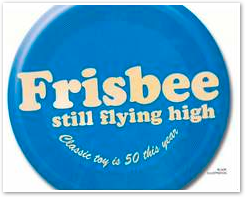
Originally published in The Blade on Friday, May 18, 2007
Classic toy turns 50 this year
BY RYAN E. SMITH
BLADE STAFF WRITER
So many toys never get to grow old. They're a fad for a while — pet rocks, anyone? — and then, well, they're not.
Which makes it that much more interesting that the Frisbee, first sold commercially by Wham-O in 1957, is celebrating its 50th birthday this year.
Few toys have lasted that long. Think about it: Barbie isn't 50 yet. Neither is G.I. Joe.
So you might say the Frisbee is flying on rarified air.
"There's not as many classic toys that are still around after 50 years," said Reyne Rice, a toy trends specialist with the Toy Industry Association, the trade organization for North American toy manufacturers. "You've got Mr. Potato Head, Monopoly, Scrabble ..."
You get the idea.
"As times change, toys tend to reflect the times and the trends. Kids move on to the next thing or the next brand," Ms. Rice said.
That didn't happen with the Frisbee.
To find out why, let's go back to the beginning, back to 1937 when Walter Frederick Morrison discovered some high-flying fun during a game of toss at a family Thanksgiving gathering.
"The inspiration came from a large popcorn can lid that would fly when you flipped it," said Mr. Morrison, now 87 and living in Utah.
The World War II pilot went on to design a plastic version that he called the Pluto Platter, a nod to Americans' fascination with flying saucers.
In 1957, he sold the rights to manufacture and promote his invention to Wham-O, which, according to the company, it later renamed Frisbee after seeing students at Yale University flinging pie tins from the Frisbie Baking Co.
Phil Kennedy, 60, a Frisbee collector and co-author with Mr. Morrison of the book Flat Flip Flies Straight! True Origins of the Frisbee (Wormhole Publishers, 2006), still recalls the wonderment of seeing the toy for the first time.
"To me as a 10-year-old, I walked into a five-and-dime and here's this little model of a UFO spacecraft that you could actually take out in the backyard and throw around. I loved it," said Mr. Kennedy, of Connecticut.
People have been flinging flat, round objects and watching them sail for centuries, but there was something timely about this toy.
"The '50s were in some ways an innocent time," he said. "Nobody had been up in space. Nobody had walked on the moon. Anything to do with rockets and spacecraft ... was something that was very interesting to people."
There's no question that the Frisbee was a product of its era, said Raymond Schuck, an instructor in the popular culture department at Bowling Green State University.
It has the fingerprints of the '50s all over it — a time when Americans started moving to the suburbs, where big lawns and plenty of green space provided the perfect place to toss the new toy.
It was also an invention that recognized the timeless importance of socializing through physical activity, he said.
"You socialize while you're doing it," Mr. Schuck said. "I picture the students on the college campus, their beers on the ground next to them, throwing their Frisbee back and forth."
The same happens on beaches, in parks, and in backyards all across the country because anyone can do it. The Frisbee is affordable — the classic model still sells for a few bucks — and simple to use.
"Anybody can kind of throw it," Mr. Schuck said. "You throw it and you see it glide through the air and there's a certain elegance to it."
That simplicity extended to the original rules of the game. There were none. Instead, written on the underside of the original models was the suggestion: "Play Catch - Invent Games."
People certainly had no problem with that.
A group of high school students in New Jersey took a game of catch, added some elements of football, and came up with Ultimate Frisbee in 1968. Today, more than 100,000 play the non-contact game in the United States, according to the Ultimate Players Association.
Why do they play? That's an easy question for Michael Kapoor, 26, a law student at the University of Toledo who started a club team there a few years ago, and who was drawn by the spirit and athleticism of the game.
"It's very ultimate," he said. "You'll see people, they'll lay out all the time. They're going to be diving over people. So it's very intense."
Another popular pastime is Frisbee golf, a game similar to regular golf that was formally introduced in 1975. Players throw discs along a predetermined course with the goal of landing them in metal baskets using the fewest number of throws possible.
There are more than 1,800 disc golf courses in the United States, according to the Professional Disc Golf Association. That includes courses in Toledo's Ottawa Park, Bowling Green, and Monroe County, Michigan.
Mike Michalak, 44, of Lambertville, likes to play at least twice a week. He's vice president of the Toledo Area Disc Golf Association, and like many aficionados, he played a rough form of the game when he was younger.
"We used to basically try to take a Frisbee and hit objects with it," he said.
It's a game that can be played for little cost and with any number of people. But most importantly to Mr. Michalak, it's a game that's played in a natural setting.
"You're kind of like one with the environment," he said.
People have come up with plenty of other things to do with a Frisbee in 50 years — throw it to your dog, throw it as far as you can, do acrobatic tricks with the discs. It's enough to make Mr. Morrison's head spin.
"Who would ever expect something as simple as a Pluto Platter to become an international toy," he said. "It's incredible. It's a wonderment."
BLADE ILLUSTRATION

